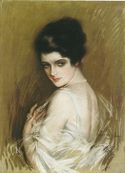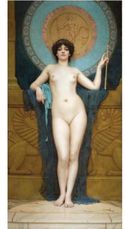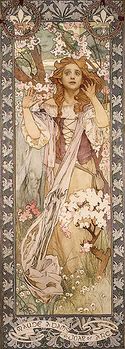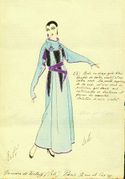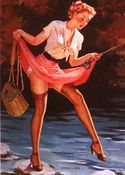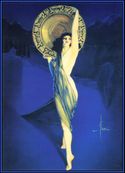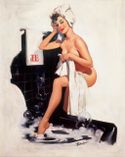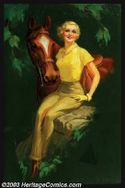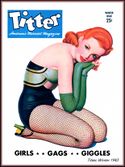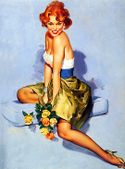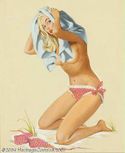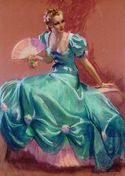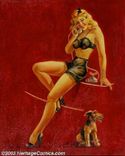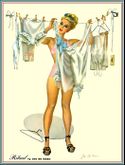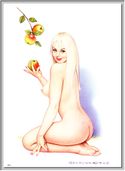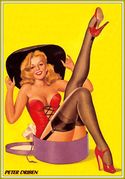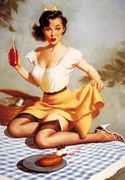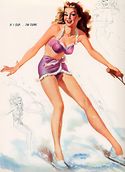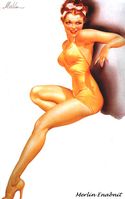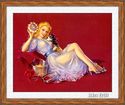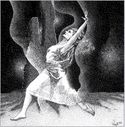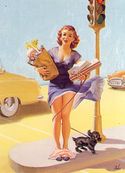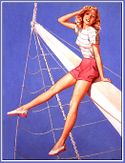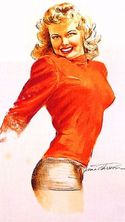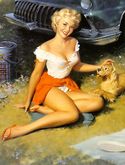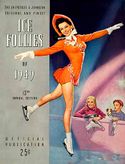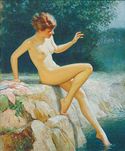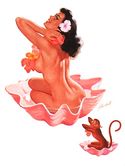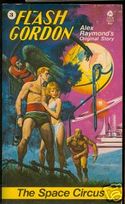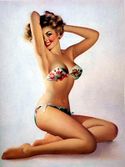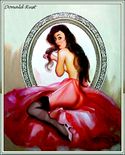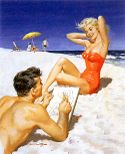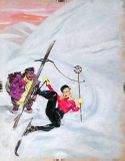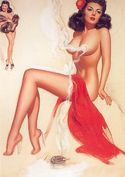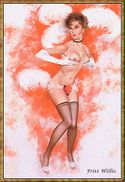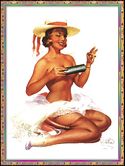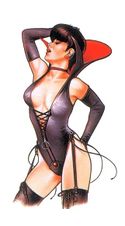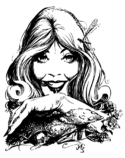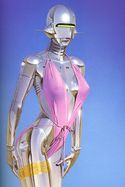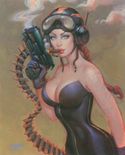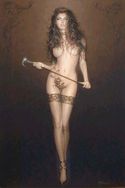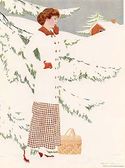Pin-up artist FAQ
 |
1910's • 1920's • 1930's • 1940's • 1950's • 1960's • 1970's • 1980's • 1990's • 2000's • |
- Also see the page [ YANK ] for pin-ups who posed in YANK magazine
A lot of the original information was found in the "Who IS FAQ" on alt.binaries.pictures.erotica.pinup
I have expanded their work and added examples of the artists' work to each bio.
This article breaks artists into four sections:
- Pre-classical,
- Classical,
- Post-classical, and,
- Contemporary.
Pre-Classical
- Harrison Fisher (1875-1934)
Harrison Fisher enjoyed incomparable fame from 1905 to 1920, achieving celebrity status and holding the enviable position of national beauty judge. Fisher portrayed the American woman as an outgoing, lively personality, wealthy and healthy. She rode horses, played tennis, and motored in the new automobiles while holding court for admiring men. Fisher's portrayals of such beauties added market value to dozens of novels as well as hundreds of magazines that clamored for his art on both their covers and inside pages.
"The Father of A Thousand Girls", HARRISON FISHER (1875-1934) showed an early interest in drawing and from the age of six was instructed by his father, Hugh Antoine Fisher, a landscape painter. When his family moved from Brooklyn to San Francisco, Harrison studied there at the Mark Hopkins Institute of Art. At sixteen, Fisher had begun to make drawings for the San Francisco Call and later for the Examiner. Soon after returning to New York, Fisher sold two sketches to Puck Magazine, which also hired him as a staff artist. He became noted for his ability to draw beautiful women, and his Fisher Girls became rivals to those of Gibson and Christy. The American Girl was a favorite theme for the magazine then, and Fisher did cover illustrations for most of them. For many years he was under an exclusive contract to do covers for Cosmopolitan, but eventually he restricted himself to painting portraits including many actresses and theatrical personalities.
- John William Godward (1861-1922) (American?)
Godward is yet another late 19th century neoclassical painter who was bulldozed aside with the coming of the modernist stampede of the early 20th century. The sum of the information available on him and his works fills perhaps half a page. Unfortunately Godward committed suicide after being savaged by critics and reportedly left a note indicating something to the effect that the world was not big enough for him and a Picasso.
John William Godward was among the brightest stars of the late Graeco-Roman painters, during classicism's twilight and final extinguishing. Some believe he equalled Tadema in the depiction of marble and flowers and Leighton in the depiction of drapery. Godward's oblivion was caused by his own reclusive nature, society's loss of interest in classical subject painting, aggressive modernist art and the direct efforts of his disapproving family to plunge him into obscurity.
Swanson's biography and catalogue raisonne thoroughly examine this forgotten classicist and illustrate nearly every known Godward painting. For the first time we are able to read about the life of a very private man who pushed the classical ideal far into a century which has known the deepest inhumanity. Godward's art was more than escapist; it was purposely beautiful in an age plunging headlong into atrocity. He sought to portray peace, feminine beauty and ideal perfection by marvellously painting and composed pictures of beautiful women in halcyon classical environments.
He was not just a painter or a picture-maker. Rather he was a desperate contriver of dream icons, symbolising the archetypal perfect world of women, beauty and peace. For Godward's art was not only an aesthetic exercise but rather art therapy, masking a troubled soul. Through these pictures he lived his self-contained life until melancholia, fed by ill health and increasing artistic criticism, overwhenmed his fantasy world of serenity. A hapless victim of his own personality, unable to make his way in a hostile world, Godward simply ended it all.
====== (Thanks to Charles Perrien for the last 3 paragraphs)
- Alphonse Maria Mucha(1860-1939) (Czechoslovakian)
Alphonse Mucha was a very influential but seldom mentioned figure in the history of art. He is more than anyone else responsible for the "art nouveau" style that developed around the turn of the century and applied his considerable talents to a wide variety of pursuits ranging from painting and sculpture to poster, magazine, and calendar illustration, and product and architectural design. It is probably as much because he did things other than paintings to be hung in museums that many of the leading artistic institutions have ignored his work for most of this century. But the fact that he opposed the cubist revolution and made recognizable and beautiful images meant that the critics of the 20th century would ignore his work. Those are the very things of course that make him worthy to appear here.
In addition to being a brilliant painter and illustrator, Mucha was also a master of design.
Mucha was a careful planner and made extensive studies of his subjects before producing the final result, sometimes using photographs as models (in much the same way as Maxfield Parrish did).
- Erté - Born in St-Petersbourg, Russia (1892 - 1990)
The Russian-born painter Romain de Tirtoff, who called himself Erté after the French pronunciation of his initials, was one of the foremost fashion and stage designers of the early twentieth century.
From the sensational silver lamé costume, complete with pearl wings and ebony-plumed cap, that he wore to a ball in 1914, to his magical and elegant designs for the Broadway musical Stardust in 1988, Erté pursued his chosen career with unflagging zest and creativity for almost 80 years.
On his death in 1990, he was hailed as the "prince of the music hall" and "a mirror of fashion for 75 years".
Born in St. Petersburg and destined by his father for a military career, Erté confounded expectation by creating his first successful costume design at the age of five, and was finally allowed to move to Paris in 1912, in fulfilment of his ambition to become a fashion illustrator.
He soon gained a contract with the journal Harper's Bazaar, to which he continued to contribute fashion drawings for 22 years.
Erté is perhaps best remembered for the gloriously extravagant costumes and stage sets that he designed for the Folies-Bergère in Paris and George White's Scandals in New York, which exploit to the full his taste for the exotic and romantic, and his appreciation of the sinuous and lyrical human figure.
As well as the music-hall, Erté also designed for the opera and the traditional theatre, and spent a brief and not wholly satisfactory period in Hollywood in 1925, at the invitation of Louis B. Mayer, head of Metro-Goldwyn-Meyer.
After a period of relative obscurity in the 1940s and 1950s, Erté's characteristic style found a new and enthusiastic market in the 1960s, and the artist responded to renewed demand by creating a series of colorful lithographic prints and sculpture. This luxuriously illustrated museum contains a rich and representative selection of images, drawn from throughout Erté's long and extraordinary productive career.
From: http://www.renoirauction.com (Thanks to Wilph!)
Classical
Arnold Armitage is a British oil painter who specialised in wholesome country girls. Glowing blonde hair, apple cheeks, gently scooped neckline (suggesting but not stressing shapeliness), plus the rustic fence and flower garden at her lap, all add up to a romantic, bucolic fantasy.
The country girl sub-genre was frequently touched upon by Elvgren himself, but Art Frahm that split personality who specialised in idealised prom dates and girls with their underpants around their ankles joined Armitage in presenting wholesome, attractive country gals in less than overtly sexual poses and situations.
Armitage's girls appeared both in the USA and Great Britain. England's first major pin-up artist was Sketch magazine's Raphael Kirchner during World War I, followed by the American Merlin Enabnit in World War II. Lambert, Van Jones and Archie Dickens are other prominent British pin-up artiste whose work has seldom crossed the Atlantic.
However, it is noted that he was known by English and American audiences only by his last name.
The father of the American pin-up, Armstrong (1899-1960) came to fame in the 1920s. His use of the pastel medium spawned such famous followers as Billy De Vorss, Earl Moran and Zoe Mozert. Though he did many covers for magazines and song sheets, it was Armstrong's dazzlingly smiling, flowingly mane, supple-limbed calendar girls for Brown & Bigelow that set the glamour-art standard.
Seattle-born Armstrong, who studied at the famed Chicago Art Institute, contributed covers to such periodicals as College Humour, Life and Shrine magazine; his advertising accounts included Oneida Silverware. A one-time pro boxer and devoted seaman, ruggedly handsome Armstrong was rarely seen without his yachting cap.
With a pastel palette of 3600 colors, Armstrong worked with models in his Manhattan studio, creating enormous originals (typical size 39" by 28"), surviving examples of which are today among the most valuable pin-ups.
- Joyce Ballantyne
Nebraska-born (1918) Ballantyne is a noteworthy member of the small "girl's club" among pin-up artists. Like Zoe Mozert, she captured a fresh, real sensuality in her subjects, and a palpable sense of fun. Like Mozert, she was (and probably still is) as attractive as a pin-up herself blonde, green-eyed, and frequently barefoot.
The vivid oils of advertising artist Ballantyne (Coppertone's little girl whose bathing suit is being tugged off by a playful puppy is hers) rival those of her one-time instructor Gil Elvgren. While this example clearly echoes Elvgren (whom she repeatedly assisted and even ghosted), Ballantyne's women were often depicted in a looser, more natural fashion than the studiously coy poses of her male counterparts.
- Roy Best
From the 1930s to the mid-1940s, Roy Best became known for creating strong, crisp pictures of all-American girls with pastels that reproduced beautifully when printed as calendars.
Best was born in Waverly, Ohio, and worked on railroad construction crews to support his studies at the Art Academy of Cincinnati. He subsequently moved to Chicago and enrolled in the Art Institute there. Later, in New York, he was represented by American Artists, Sidney and Celia Mendelsohn's well-known agency on West Forty-fourth Street which handled almost a hundred top-flight illustrators, including Norman Rockwell. In the I 930s, he painted several front covers for The Saturday Evening Post.
By 1931, Best was executing fabulous pastels of sensuous Art Deco pin-ups and nudes for the Joseph C. Hoover and Sons calendar company. That year, he received a phone call from the Whitman Publishing Company in Racine, Wisconsin, asking him to consider an assignment for a series of twenty-one full-color, full-page illustrations for a children's book. Best accepted and went on to create a masterpiece - The Peter Pan Picture Book, based on the J. M. Barrie play.
In 1942, Best came to the attention of Brown and Bigelow, which offered him the opportunity to paint pin-ups and glamour art for the calendar market. Accepting the company's generous financial offer, Best went on to a highly successful calendar career.
While he has achieved a laudable amount of latter-day fame, Enoch Bolles remains largely a figure of mystery. He apparently ended his days in an insane asylum, where he "improved" on his wonderful canvases by adding such touches as jagged jewelry and hovering phalluses. It's more pleasant to peruse Francis Smilby's wonderful book Stolen Sweets (1981, Playboy Press), and Robert A. Brown's two Spiry card sets (Kitchen Sink Press), all of which brim with wonderful images of exuberant Bolles girls.
Sleek, naughty, these flapper-style dolls, with their bee-stung lips and voluptuous figures, lounge in lingerie and other unlikely forms of sex-fantasy dress-up as - exemplified by this blonde in fur coat and bathing suit. Bolles was a genius, and his oils reveal an artistry second to none in the pin-up genre.
After Alberto Vargas and George Petty, Enoch Bolles was the best known of the Deco-era pin-up artists, mostly because of the massive exposure his images received on newsstands from coast to coast. Bolles' art - both in terms of technique and subject matter, the playful, yet somewhat racy flapper girl - clearly exerted a strong influence on many artists of his time.
Bolles began his career in 1915, when he was hired by the Dell Publishing Company to paint front covers for its line of spicy pulp magazines. He, like many other pin-up artists of the early Deco era, found a ready-made audience among the mostly male readership of the pulps. Film Fun was the pin-up magazine that immortalized the Bolles name. From 1921 to 1948, it carried his cover art pin-ups, which the American public came to recognize almost as much as the Petty Girl from Esquire. Bolles worked for many other pulps, including Gay Book and Cupid's Capers, which invited him to design their inaugural covers, and Spicy Stories, which had the biggest circulation among such magazines.
Bolles' pin-up girls were fun-loving and sexy, often provocative in their poses but occasionally caught in embarrassed or slightly self-conscious moods. Usually full of energy and brimming with health and a sense of adventure, they had almost childlike faces that contrasted with their sensual bodies. Bolles often incorporated Art Deco backgrounds, spotlights and other props, and clothing such as flimsy negligees and wet bathing suits into his work.
Bolles painted in oil on canvas in a variety of sizes ranging from 10 x 8 inches (25.4 x 20.3 cm) to 14 x 11 Inches (35.6 x 27.9 cm) for his pulp magazine pin-ups all the way up to 30 x 24 inches (76.2 x 61 cm) for the Film Fun assignments. The wide variety of primary colors he employed was notable at a time when many of his contemporaries were using much more subdued tonal schemes. Although Bolles was a prolific artist, only a handful of his original paintings exist today.
Very little is known about Bolles' life. Probably born in the Chicago area, he worked in New York City, where he could be near the many publishing houses specializing in pulps and racy men's magazines in the 1920s and 1930s. It is rumored that Bolles had emotional problems near the end of his life that led him to over paint some of his Film Fun covers, creating horrific expressions on his formerly fun-loving pin-up girls.
Born in 1920 in Kansas, Alfred Leslie Buell, paperback cover artist, magazine illustrator, and Coca-Cola artist worked with Elvgren in the Sundblom shop in Chicago. His oils are among the best pin-ups in that medium, although existing originals (on board, not canvas) are much smaller than those of Elvgren, Ballantyne and Ekman.
Perhaps that explains a certain delicacy in his work; Buell's pretty girls really are "pretty." These girls-next-door are captured in such typically innocent pursuits as sewing, playing tennis, or riding a swing. Underclad, as they are, Buell's girls have a wholesomeness, an ingenuousness, rare in the pin-up form.
Often his pin-ups have solid black backgrounds, a la Walt Otto; in other cases, he creates full settings, particularly in the pseudonymous paintings (signed "Al Leslie") he did when moonlighting from Brown & Bigelow at lesser companies. In these paintings Buell strayed into the area of embarrassed coy cuties, often accompanied by cute puppies who inadvertently caused skirts to be raised.
- Eddie Chan
After Al Moore's three-year solo stint as Esquire calendar artist, the 1952 edition presented the next batch of contenders, including Robert Patterson, Ward Bennett, Ren Wicks and Chiriaka. Eddie Chan, veteran advertising artist and Hearst America,' Weekly cover artist, also contributed to the '52 calendar, and to the 1953 Ballyhoo calendar, showcasing charming, shapely, wide-eyed women.
Chan reflected the modern, post-war approach of Jon Whitcomb and Al Parker realistically drawn figures and strong design elements combining with gouache to provide a sharp-edged, flatter look. This plus pastel coloured dress and props typified the illos in such magazines as Saturday Evening Post and Collier's.
The ultra-modern, even harsh style of, Mike Ludlow brought the famed calendar series to a close in 1957, by which time Playboy's similar but photographic calendars had made Esquire's painted ladies an anachronism.
- Ernest Chiriaka
Esquire's search for a Varga replacement included such gifted commercial artists of the late 1940s and early 1950s as Ward Bennett, Ren Wicks, Robert Patterson, Eddie Chan and Al Moore. The latter was close to being declared winner, but ultimately Ernest Chiriaka (born 1920) was as close to a new pin-up star as the magazine came. Chiriaka contributed solo pin-up calendars to Esquire from 1953 through 1957. Chiriaka's women (they weren't really "girls") were sultry and glamorous, often exotically costumed, and sometimes completely un-costumed. These were steamy, sophisticated, not at all wholesome pin-ups. Like De Mers, Chiriaka denoted the post-war modern approach striking design juxtaposed with realistically rendered women. The use of gouache allowed for more gradations of skin tone, trading supple Elvgren smoothness for a palpably sensual earthiness.
In the 1940s and '50s, Chiriaka's other area of expertise oddly - enough, considering the modern elegance of his sex goddesses - was western pulp and paperback covers.
- Bradshaw Crandell
Bradshaw Crandell (1896-1966) was one of the most famous "pretty girl artists" of his day. The astonishingly beautiful blonde is typical of Crandell's ability to merge romance, glamour and sex appeal.
But Crandell rarely contributed a "pure" pin-up. His fame chiefly rests with his twelve years of cover girls (in the 1930s and '40s) for Cosmopolitan, where he succeeded famed cover-girl specialist Harrison Fisher. He provided covers for numerous other prestigious magazines, including Redbook, Judge, Saturday Evening Post and The Ladies' Home Journal. He also produced movie poster art for Twentieth Century Fox.
Occasionally he did a calendar or took an advertising assignment that fell more squarely in the realm of the pin-up, proving that had he wanted to go head to head with Petty, Vargas and the rest, he would have been high on every body's final list.
- Edward D'Ancona
Evidence suggests Edward D'Ancona worked out of Chicago, and is probably yet another graduate of the influential Haddon Sundblom shop; he is rumored to be the son of an artist father.
His painterly style, the lush brush strokes, the warmth of his colours, the girl-next-door beauty of his subjects, suggest a close linkage to both Elvgren and Sundblom. A prolific contributor of calendar-girl art to numerous companies, D'Ancona's earliest works appear to have been for Louis F. Dow; these are stiff, even awkward pin-ups.
Later, an improved D'Ancona landed advertising accounts, including several soft drink firms who capitalised on his Sundblom-like style, so identified with Coca-Cola. By the early 1950s, when he joined the ranks of Art Frahm and Jules Erbit in painting glamour girls in gowns, he could hold his own with the best. Like Otto, his girls were less coy than most, brazenly confronting the viewer with a direct gaze.
- Ruth Deckard
Chicago-area artist Deckard worked for Louis F Dow in the late 1940s and into the '50s, creating cuties who were often caught on the phone, sometimes with playful puppies nipping at well-turned ankles. The apparently self-taught, almost primitive Deckard turned out some truly awkward paintings, but even the worst of them has a wide-eyed naïve charm.
Deckard was assumed to be a man until a small handful of originals turned up recently, revealing the artist's first name to be Ruth. Ruth Deckard joins Mozert, Ballantyne and Frush on the small but impressive list of ladies who painted pin-ups.
- Joe De Mers
In the late 1940s, when Alberto Vargas left Esquire in a flap over money, the sophisticated men's magazine tried to find a replacement among the most talented commercial artists of the day. One of these was Joe De Mers, born in 1910 in San Diego, California, a fine artist who as early as 1933 had an exhibition at the Museum of Modern Art.
De Mers had a remarkable career production illustrator for Warner Brothers Studios, successful book publisher freelance commercial artist appearing in such top markets as The Saturday Evening Post, McCall's, Reader's Digest, and Ladies' Home Journal. At last report he had his own gallery on Hilton Head Island, South Carolina.
His startling use of abstract design with more realistic looking women is typical of modern, post-World War 2 magazine illustration. After contributing to a 1948 Esquire calendar, he was not chosen to be the new "Varga," but did a few pin-ups for Shaw-Barton, earning a minor but interesting position in the history of pin-up art.
- Billy De Vorss
At first glance, Billy De Vorss might be dismissed as a shameless imitator of Rolf Armstrong, whose influence extended even to De Vorss' signature. Working frequently with live models, the self-trained De Vorss painted in pastels, like Armstrong, and his beauties (like Armstrong's) often displayed dazzling smiles and sleek limbs.
But De Vorss had his own special charm his works, while uneven, have a warmth and glow, his girls-next-door radiating a good-natured sexuality. Where Armstrong conveyed glamour, De Vorss conveys romance His idealised women seem to benefit from his lack of formal training. Perhaps it's no coincidence that his favourite model was his wife.
A native of St. Joseph, Missouri, De Vorss worked out of New York's Greenwich Village from the mid-'30s until his early 1950s return to the Midwest. His earliest calendar girls appeared under the Louis F. Dow imprint.
- Archie Dickens
Born 1907, Dickens attended the Slade School of Art in London and became a free-lance commercial artist in the 1930s. Pin-up was just coming into vogue. Archie yearned to paint girlie art but needed to help support his family. He emigrated to New Zealand in 1937 and joined an advertising agency in Auckland. There he painted his first pin-up.
In 1939, he went to Australia an worked for a studio in Sydney. His pin-ups were soon in great demand. After some time, he was compelled to join the Australian Army. so his art work was put aside for awhile. At the end of the war he married an Australian girl and moved back to London where he produced saucy pictures.
"Cheeky", "saucy", "randy" and a variety of other British euphemisms can be employed when describing the works of Archie Dickens. An Englishman from the old school, his fondness for lovely young innocents in not-so-innocent situations has delighted pin-up enthusiasts throughout the world for several generations.
Angelic faces with devilish designs has always been the hallmark of this illustrator. With a sly wit and a teasing twinkle in his eye, his work has gained many admirers, including a certain British Prime Minister. In the year 2000, England's Tony Blair made some amusing headlines by sporting a pair of eyebrow-raising cufflinks. They featured a nude on her knees, as illustrated by the inestimable Mr. Dickens.
{Charlie} (Biographical information from two websites about Archie Dickens.)
The bold, outrageously fetishistic pin-ups of Peter Driben "keyhole" glimpses of faintly S & M-oriented imagery leaning on loony lingerie, fish-net stockings and spike heels from the Irving Klaw collection keep threatening to make the artist a latter day star. It hasn't quite happened yet, though reports of Driben's oil originals going for Elvgren level prices indicate it may.
Driben's earliest pin-ups were pale Film Fun imitations of EnochBolles, but the artist came into his own as house cover artist for the Bob Harrison stable of girlie magazines. Driben's voluptuous, leggy dames in their eye-popping outfits have a sense of humour that keeps the dark side of fetishism at bay; their appearances on Beauty Parade, Eyeful, Flirt, Titter, Whisper and Wink make those magazines highly collectible even when Betty Page isn't a featured model.
Driben was painting portraits of Palm Beach socialites at the time of his death in the late 1970s.
- Harry Ekman
Chicago artist Harry Ekman Harry was an apprentice to fellow Sundblom shop veteran Gil Elvgren, developing a lush style in oils uncannily like that of his mentor.
His girls have the same fresh, wholesome glow as Elvgren's, and are seen in such typical Elvgren-ish situations as bicycling, wading, and walking the dog.
Assisting his colleague in the 1960s, Ekman may even have "ghosted" certain Elvgren signed paintings. His own work appeared under both the Brown & Bigelow imprint and Shaw-Barton.
Like Elvgren, Ekman specialised in calendars but also worked in advertising.
- Freeman Elliot
When K.O. Munson left Brown & Bigelow, Freeman Elliot, veteran artist of pin-up style covers for Hearst's Pictorial Weekly, took over the famous "sketchbook" calendar series. Elliot's girls were gorgeous, impossibly long limbed creatures, often involved in whimsical situations painting the house in a bikini, answering the phone in a towel, cooking in nothing but a tiny apron.
Elliot's style was closer to Munson's than Earl MacPherson's, and his girls have a glamour and glow rivaling Elvgren's. His "sketchbook" pages are nicely cluttered, side sketches in both pencil and colour embellishing the comic situations, even telling a story of sorts.
What medium exactly Freeman is working in is uncertain; the handful of originals that have surfaced are oils on board. He also contributed several images to the 1953 Ballyhoo calendar, the other contributors to which were Esquire pin-up artists. Here his style had evolved into a lushly sensual one similar to Al Moore and Ernest Chiriaka.
Gil Elvgren|Gillette A. Elvgren]] (1914-1980) has joined the ranks of Petty and Vargas as one of the premiere American pin-up artists...the Norman Rockwell of cheese-cake. His heroines are often caught in humorous but distressing situations.
His exquisite oils of gorgeous girls-next door, their skirts often blowing up to reveal lovely nylon-clad limbs - rival his mentor Haddon Sundblom's "Coca-Cola" Santa's for sheer nostalgic pleasure. Born in St. Paul, Minnesota, Gillette A. Elvgren attended University High School. After graduation he began studying art at the Minneapolis Art Institute.
Some of Gil's fellow students were Coby Whitmore, Al Buell, Andrew Loomis, Ben Stahl and Robert Skemp; many of whom would later work for Coca-Cola, as would Elvgren. He graduated from the Academy during the depression at the age of twenty-two. Gil joined the stable of artists at Stevens and Gross, Chicago's most prestigious advertising agency. He became a protege of the monumentally talented Haddon Sundblom, who was most famous for his Coca-Cola Santa's.
Working in Sundblom's shop (Stevens-Gross) with Al Buell and Andrew Loomis (among other noted illustrators), Elvgren contributed to various Coca-Cola ads himself. Sundblom who had studied at the American Academy of Fine Art taught his star pupil the lush brush stroke technique that makes Elvgren's girls such glowing wonders.
In 1937, Gil began painting calendar pin-ups for Louis F. Dow, one of America's leading publishing companies.
These pin ups are easily recognisable because they are signed with a printed version of Elvgren's name, as opposed to his later cursive signature.
Dow paintings were often published first in one format then painted over with different clothes and situations. These 'new' paintings were then republished and distributed to an unsuspecting public.
Around 1944, Gil was approached by Brown and Bigelow, a firm that still dominates the field in producing calendars and advertising specialties. They offered him $1000 per pin-up, which was substantially more than Dow was paying him. Elvgren signed on with B&B. Gil's Brown and Bigelow images all contain his cursive signature.
By the terms of Elvgren's contract with B&B, he would turn out twenty calendar girls each year, ranging from cowgirls of the golden west to sultry sirens of the Riviera.
Elvgren looked for models with vitality and personality, and chose young girls who were new to the modeling business. He felt the ideal pin-up was a fifteen-year-old face on a twenty-year-old body, so he combined the two.
An Elvgren model was never portrayed as a femme fatale. She is, rather, the girl next door whose charms are revealed in that fleeting instant when she's been caught unaware in what might be an embarrassing situation.
Gusting winds and playful plants grab at her lovely, long legs. She is intruded upon as she takes a bath. Her skirts get caught in elevator doors, hung up on faucets, and entangled with dog leashes. The elements conspire in divesting her of her clothing.
Gil Elvgren's paintings lend credence to the phrase, "A picture is worth one thousand words." His 30" by 24" oils on stretched canvas are second in value only to originals by Vargas.
- Merlin Enabnit
In 1940, Merlin Enabnit was hailed by Life magazine as England's answer to George Petty; the Merlin Girl was a big favorite of British "Tommys" (G.l.s) via regular appearances in Sketch magazine. Merlin's sleek, airbrushed damsels certainly do evoke Petty, although they have a bounce and personality of their own. Postcards, magazine covers and a campaign for White Owl cigars attempted to make Merlin a hit in the States, but his fame never approached Petty level.
Ironically, Merlin (a fellow of the Royal Society of Arts of England) was not British he was born near Des Moines, Iowa, in 1903, and worked out of Chicago. His fame in America centered upon his portraits of United Nations luminaries, among others.
The artist was well-known enough for a "Merlin Enabnit's No. 1 Palette Knife" to be marketed nationally and he authored how-to books for Walter Foster on painting with a palette knife, portraiture, and use of color.
- Jules Erbit
Little is known about Jules Erbit, but this master of pastels was one of the most prolific pin- up artists from the 1930s into the 1950s. His lovely women grace calendars, posters and prints, published by C. Moss, Brown & Bigelow, and others.
Bathing-suit beauties are rare among the works of Erbit, who specialised in more sedate, but nonetheless sensual images. Erbit typifies the glamour approach a characteristic Erbit pin-up features a lovely woman in a gown leaning against the rail of a ship, or lounging in a garden. It's a soft-focus, flowers-in-the-hair world.
The artist's Masterful use of pastels for his radiant beauties puts him securely in the camp Rolf Armstrong followers; but, unlike Billy De Vorss, Erbit has his own immediately distinctive style. Where Erbit most resembles Armstrong is in the size of the (few known surviving) originals massive works, they typically measure 14" by 31".
- Virgil Finlay's women of the ages
-
- By Chuck Miller
Virgil Finlay has been called "the greatest craftsman in the history of science-fiction illustration." Throughout the 1930s, '40s, and '50s, Finlay reigned supreme as the acknowledged master of fantasy, science-fiction, and horror illustration. His work appeared in the pulp magazines, the predecessors of the comics: Weird Tales, Famous Fantastic Mysteries, Startling Stories, Wonder Stories Annual, Fantastic Universe, and many others. When pulps changed format to digests he appeared in Galaxy, Amazing, Fantastic, and If.
In the 1940s Finlay did some work in the comics for DC's Real Fact Comics. These two-to-four-page features were reprinted in the early '50s in Julius Schwartz's Strange Adventures. He also did a six-page strip, "The Mad Planet," for Mystery in Space.
Finlay's imaginative and attractive illustrations appeal to many, fans. But fellow artists and art lovers marvel at his distinct, jewel-like renditions employing the painstaking stipple and crosshatching techniques of an earlier era of illustration. From his fabulous women to his horrific monsters, to scenes from legendary pasts and fantastic futures, Finlay's delicate, precise style is truly awe-inspiring.
According to Gerry de la Ree, "Finlay's black-and-white drawings were accomplished using an assortment of techniques, employing pen, brush, spatter, lithographic pencils, sponges, and knives on a variety of paper; the majority were done on scratchboard. His color work was generally done in oil thinned with quick drying siccative, and sometimes combinations of ink, watercolor, gouache, and oil.
"He refined his stipple technique throughout his career. He explained it this way: `Using a 290 lithographic pen (which has an extremely fine point), I dip the pen in India ink and allow only the liquid to touch the drawing surface, which is normally scratchboard. The point is then wiped clean and re-dipped for the next dot.' Obviously, this was a time-consuming operation."
Finlay's career paralleled the emergence of the grand masters of the field. He illustrated stories by Robert E. Howard, H.P. Lovecraft, Robert A. Heinlein, A. Merritt, Isaac Asimov, Andre Norton, Clark Ashton Smith, Seabury Quinn, Edgar Rice Burroughs, L. Ron Hubbard, Arthur C. Clarke, C.L. Moore, Henry Kuttner, Robert Bloch, L. Sprague de Camp, Jack Vance, and many others.
He illustrated several books which have become classics, including the wonderful Christmas tale Roads by Seabury Quinn, The Ship of Ishtar by A. Merritt, and a rare 1935 paperback edition of Shakespeare's A Midsummer Night's Dream. Perhaps most well known is his black-and-white dustjacket illustration for The Outsider and Others by H.P. Lovecraft in 1939, the first Arkham House title published.
From 1938 to 1951, Finlay produced more than 800 drawings and covers for The American Weekly newspaper supplement edited by A. Merritt and published by William Randolph Hearst. Because of the increased pay scale he was able to devote vast lengths of time to this work, and it is considered some of his best work. A bound portfolio of 24 drawings from The American Weekly was published in 1977 by Tim Underwood and Russ Swanson.
Throughout the years other books and collections of Finlay's art have appeared. Famous Fantastic Mysteries issued three portfolios of his work in the 1940s. In the 1950s and 1970s other portfolios were produced by Robert Weinberg and others. Donald M. Grant published two volumes of his work in the 1970s and between 1975 and 1981, Finlay collector extra ordinary Gerry de la Ree issued several portfolios and seven hardcover volumes of Finlay's work. Today, these books are much in demand and difficult to obtain.
Finlay died of cancer in early 1971, but his work is fondly remembered and extremely collectible. Original black-and-white illustrations often sell for more than $1000 and color paintings, especially from famous Weird Tales covers, are rarely offered for sale.
Virgil Finlay's Women of the Ages collects the best of his illustrations depicting women from the distant past to the far future. This volume is published by Underwood-Miller with the cooperation of Lail Finlay Hernandez, Virgil's daughter, and the generous help of Gerry de la Ree. Robert Weinberg also lent his assistance and the color cover reproduces a stunning painting in the collection of Steve Korshak.
(Source: Comics Buyer's Guide #972 - July 3, 1992)
Versatile Art Frahm yet another Chicago area artist and a likely Sundblom-shop graduate compares favourably with such master technicians in oil as Elvgren and Ballantyne. But his significance comes out of his defining roles in two seemingly opposite pin-up categories.
Many of his works were outstanding examples of the glamour genre, in which Frahm was a star as shining as those overlooking this lovely pink-gowned debutante. His perfectly coifed, daring décolletage dressed beauties glowed in the midst of romantic soft focus settings.
But Frahm whose commercial art ranged from magazine cover illustration to zany "hobo" calendar paintings also excelled in (and perhaps created) the campily sexist "ladies in distress" series for publisher A. Fox, in which a lovely girl is Literally caught with her panties down. Her lacy undies slipping to her ankles while she's in the process of bowling, walking the dog or changing a tire. Oops!
- Pearl Frush
One of the handful of major female pin-up artists, Pearl Frush makes a logical third with Zoe Mozert, who excelled in pastels, and Joyce Ballantyne, who shone as a painter of oils.
Frush's medium was watercolour, although it is not always apparent in the published versions of her works.
Fairly prolific in the 1940s and '50s, Chicago artist Frush produced fresh, beautiful, shapely pin-up girls who share with the women of Mozert and Ballantyne an individuality and reality the men in the field seldom achieved. Her originals are comparatively tiny (typically 19" by 14"), and reveal a delicate, flawless technique as beautiful as her subjects. She may be Vargas' only true rival in watercolour, and Petty's in airbrush.
She was not averse to Elvgren-style tease a Frush girl could purse her lips and look coyly at the viewer with the best of 'em but Frush more often presented her young women in a straightforward manner. By the mid-1950s she was capable of near photographic perfection.
One of the most successful and imitated of pin-up artists, Mac Pherson (born in Okalahoma in 1910) originated the famous "Artist's Sketchbook" series for Brown & Bigelow, in which a central, finished figure is augmented by preliminary-style side sketches. World War 2 interrupted his B & B service, and K.O. Munson became the first of his many successors. After the war, Mac signed with Shaw-Barton for a similar successful series.
"Winter Scene," circa 1950, is, typically, a pastel, and the cartoony snowman pencil sketch. Mac worked with live models, and men's magazine spreads of him painting lovely nudes, scattered about his modernistic Southern California studio, added to his legend.
The versatile Mac Pherson also had a considerable reputation as a Western artist. In addition, he had begun a new series of signed limited edition pin-up prints for Stabur Graphics. Earl Mac Pherson died in 1993.
- Bill Medcalf
20 years on the staff at Brown and Bigelow. All of his art education came from schools near his hometown of Minneapolis, under teachers such as Stan Fenelle and Cameron Booth.
Though not as prolific (or nearly as well-known) as Gil Elvgren, Medcalf is of all the would-be Elvgrens, including both Ekman and Ballantyne the master's nearest equal, turning out lushly rendered oil paintings of gorgeous All American girls.
Medcalf's work turns up on calendars, both in girl-next door tease situations and in the glamorous ball-gown genre.
A St. Paul artist who worked for Brown & Bigelow, he seems to have primarily devoted himself to providing pin-up girls to top advertising accounts, including Sylvania ("Miss Sylvania") and Kelly Springfield Tires.
Heir apparent to Varga at Esquire was Al Moore, who shared the magazine's 1948 calendar with Ben-Hur Baz and other major commercial artists contending for the role. In 1949, 1950 and 1951, Moore was solo artist on the best selling, most prestigious pin-up calendar around. Why he was replaced is unknown another money dispute, possibly?
Petty or Varga-level fame eluded Moore, but his pin-ups are among the best of the late 1940s early '50s, bridging the glamour girls-next-door of Elvgren and the post-war, modern look of Chiriaka and others. Like Elvgren, Moore created voluptuous dream women; but his strong design sense linked him to Chiriaka, as did his use of gouache to give his girls graduated skin tones and a sensual, earthy quality.
Moore's women were wide-eyed wonders, usually blonde, curves spilling out of bikini tops, full bruised lips promising passion. These provocative yet All American temptresses preened for the viewer, very direct, seldom coy, promising the sexual revolution that was to come.
- Earl Moran (1893-1984)
Earl Moran was a master of pastels, though he showed little if any influence of reigning Brown & Bigelow star Rolf Armstrong, whose domain he encroached upon in the '30s. Prolific Moran, Iowa-born, a Chicago Art Institute attendee, was soon a superstar himself, creating lively, sexy girls whose relationship with the viewer was seldom a teasing one. Unlike Elvgren and others, Moran did not continually re-work one type of situation, and his pin-ups have more variety than any other major contributor to the field.
Breaking in via advertising work for Sears-Roebuck, Moran went on to magazine illustration (Life), movie posters (Something for the Boys, 1944) and even co-published an early "girlie" magazine, Beauty Parade, contributing covers (sometimes under his middle name non de plume, "Steffa").
His most enduring pin-ups feature his famous late '40s model, Marilyn Monroe. Later he turned to oils, including this gowned glamour girl and, working from the late '50s until his death, an outstanding series of sensual nudes.
The most famous female pin-up artist, Mozert (1907-1993) is an exemplary disciple of the Rolf Armstrong pastel style. Often her own model, Mozert is noted for rejecting sexy-girl cliches in favour of depicting more real seeming young women, with recognisably individual features and personalities.
Her cover portraits of Hollywood starlets for such publications as Romantic Movie Stories and Screen Book were particularly popular, but she also contributed covers to such periodicals as American Weekly and True Confessions.
While the bulk of her work including such deliriously romantic nudes as "Moonglow" and "Sweet Dreams" was calendar-oriented (primarily for Brown & Bigelow). Mozert also made a mark as a movie poster artist, notably for Carole Lombard's True Confession, and the notorious Jane Russell / Howard Hughes sex and sagebrush saga, The Outlaw. Even her less sultry sirens exude both charm and sex appeal.
- K.O. Munson
When Earl Mac Pherson went into the service, "Knute" Munson was drafted from the Brown & Bigelow stable to take over the successful "Artist's Sketchbook" series. Sticking to the pastel medium, Munson replaced Mac Pherson's Petty smooth pin-ups with sharper, crisper lines, though the soft curves of his bright-eyed beauties were definitely appealing.
Soft-spoken sportsman Munson had been (and continued to be) a successful commercial artist; over the years his clients included Lucky Strike, Goodyear, Motorola, U.S. Rubber, Mars Candy and Sealy Mattress (an ad for the latter featured a fetching Munson beauty lounging on a cloud). Moving from Chicago to St. Paul in 1936, Munson was a top Brown & Bigelow pin-up artist throughout the 1940s.
He spent the '50s back in Chicago, where he opened his own studio, continuing to create pretty girl art for various companies. As painted pin-ups went out of vogue, he had the foresight to shift into shooting cheesecake photo layouts for such men's magazines as Modern Man and Figure.
Robust commercial artist George Petty (1894-1975) began a series of color cartoons for Esquire in the early 1930s, featuring gorgeous girls and their unlikely unhandsome suitors. Soon the beauties with their dazzling smiles and sleek-as-a-Buick curves held solo center stage, and the "Petty Girl" was born; in the early 1940s, when he bolted Esquire in a money dispute, Petty was replaced by (the also underpaid) Alberto Vargas.
The classy if risqué venue of Esquire gave the pin-up respectability, and Petty's amazing airbrush technique put him at the forefront of commercial artists; soon world famous, Petty was plying his pin-up trade for advertisers (including this Tung-Sol Radio Tubes image, circa 1935). Post-Esquire, he did calendar girls for True magazine and, finally, a long running series for the evocatively named Rigid Tools.
In the 1950 Hollywood film "The Petty Girl", the rotund artist was portrayed by slim Robert Cummings. "The Petty Girl" herself was more accurately depicted by Joan Caulfield.
- Walt Otto
Otto is another of the Elvgren-style pin-up artists, creating beaming American beauties in lushly painted oils on canvas (for Gerlich-Barclaw, among others). Research has neither confirmed nor denied Otto as part of the Sundblom shop.
Despite hyperrealism typical of the Elvgren School, Otto varies considerably from the Elvgren pattern in several keyways. His paintings contain cartoonish elements, particularly in the expressions of his winsome girls (as well as his cartoonist-style signature). Additionally, his women are less coy than Elvgren's an Otto girl typically attired in short shorts or bathing suit, occasionally tugged along by a cute mutt or two stares unabashedly at the viewer.
Also, Otto eschews any suggestion of setting for a solid black background, and frequently uses Petty-style cartoon outline shorthand for a phone cord or dog leash or whatever to better focus the attention on the pretty subject at hand.
- Bill Randall
Bill Randall's mid-'50s "Date Book" calendars for Brown & Bigelow were yet another of the publishing firm's spin-offs of the successful MacPherson created "Artist's Sketchbook"series. Randall's approach and style, however, were much closer to Freeman Elliot's than Mac Pherson's.
Randall apparently worked in gouache, giving his pinups a brighter and somewhat flatter (if not flat-chested) look.
He mined the Elliot-style humorous situation for further comic effect, with loose "side sketches" replaced by finished cartoon embellishments. Randall girls resemble Elvgren's in face and form preparing a pancake breakfast topless, painting lawn furniture only to have their skimpy tops snap. Yet any embarrassment was tied to tease these girls were not easily abashed. They were in fact brazenly showing off to the viewer.
Prior to his "Date Book" series, Randall did attractive but more sedate pin-up-style covers for Hearst's Pictorial Weekly.
- Alex Raymond
The late 1940s early '50s search by Esquire to replace Varga was not the first time the men's magazine had tried to supplant a superstar pin-up artist. Before landing Alberto Vargas, Esquire had tried to fill the Petty slot with one of America's top comic strip illustrators, Alex Raymond.
New York-born Raymond (1909-1956) was justly famed for his comic strips Secret Agent X-9, Flash Gordon and Jungle Jim (later he would add the detective feature Rip Kirby to this successful string). Certainly Raymond was rivaled only by Milton Caniff and Al Capp for creating "good girl art" in the comics; and his crisp romantic realism with his solid illustrative style, in the John La Gatta manner made him a perfect choice to enter the pin-up arena.
A handful of pin-ups for Esquire, and a lovely Look magazine cheerleader, represent the career in pin-ups that Raymond never quite had. Those in search of pretty Raymond girls, however, need only look to his famous comic strips for plentiful examples.
- Edward Runci
Edward Runci, like Medcalf, is an outstanding but unfortunately little known or talked-about master of pin-ups in oil. His luxuriant brush strokes reveal a talent and skill comparable to Elvgren, though Runci apparently is not a graduate of the Sundblom shop.
According to noted pin-up authority Charles Martignette, Runci was a portrait artist in Hollywood when he was approached by a calendar company for pin-ups. Martignette notes that Runci girls frequently get caught in compromising situations climbing a fence to flee a bull, dress blowing up on a Ferris Wheel ride.
Runci's early 1950s girls are rosy-checked, voluptuous, often blonde Marilyn Monroe-types whose wholesome sensuality radiates off the canvas. He also dabbled in the glamour-gown sub-genre, creating startlingly life-like effects in the silky folds of garments. Martignette speculates that Runci's artist wife may have likewise done similar, but slightly looser pin-ups also under the singular "Runci" byline.
- D.L. "Rusty" Rust
D.L. "Rusty" Rust was born in Erie, Pennsylvania in 1932. He began drawing and painting at a very early age and has never had the desire to be anything but a serious artist. His early work was directly influenced by his grandfather, Emil Rust, Gil Elvgren, Bob Toombs, and Norman Rockwell. However, he feels there has been no one single influence in his wildlife art and insists that all wildlife artists have affected his style.
For many years, Rusty's paintings concentrated on circus and portrait subjects; but recently, wildlife subjects have intrigued him more and more. His portraits include such prominent individuals as Emmett Kelly Sr., Emmett Kelly Jr., Merle Evans (Ringling band leader), Norman Rockwell, and Molly Rockwell. In fact, D.L. Rust and Norman Rockwell used to correspond regularly and in one letter Rockwell emphasised that Rusty's artwork "is very good indeed."
Rust's paintings hang in the Ringling Museum of the Circus, Sarasota, Florida; the Norman Rockwell Museum, Philadelphia, Pennsylvania; and the National Portrait Gallery of the Smithsonian Institution, Washington, D.C.
He has illustrated books for Valkyrie Press, A.S. Barnes & Co., and World of Yesterday Publications; and has provided illustrations for Reader's Digest and other magazines. His artwork has also appeared on collector's plates, appointment books, wall calendars, porcelain mugs, playing cards and jigsaw puzzles.
Rusty's ability to capture nature lies between fantasy and reality. Realism is his style, but he wants to take the collector's imagination one step further. He is an artist sensitive to nature and its surroundings. The beauty of his artistic documentation is distinctly his own. Rusty takes us not just to a creative visual, but to a place and a story.
Rust has produced more than 14,000 paintings and has 2,000 originals registered by owners with the National Museum and Gallery Registration Association (an NMGRA record!).
Rusty is the father of five children and currently resides in Florida with his wife, Faith.
Rusty has an online Web page of his work at http//netmar.com/mall/shops/rust-art/rust-ndx.htm
- Arthur Sarnoff
Sarnoff has had a remarkable career studied with Andrew Wyeth; worked for both the pulps and every major slick magazine from Saturday Evening Post to Cosmopolitan; handled top advertising accounts (creating the famous "Karo" babies campaign); painted portraits of such luminaries as Bob Hope and JFK. His work has been the subject of major exhibitions, and his lithos, prints and posters of sporting subjects and Western scenes have been popular sellers.
If that isn't enough, Sarnoff is responsible for the world-famed camp classics of anthropomorphic gambler dogs. His pool-playing dog picture, The Hustler, is said to be the best selling print in American art history.
Sarnoff was also one of the best pin-up artists around, his oils of lovely girls in negligees in the 1940s for Kemper-Thomas Company reflecting an Elvgren / Sundblom influence, with his later bathing beauties in gouache linking him to the Al Moore / Chiriaka style.
- J. Frederick Smith
In 1946, when Esquire announced its new Gallery of Glamour series, the list of artists included the name of J. Frederick Smith, along with many of the top illustrators of the day. Working out of his New York studio, Smith was a brilliant artist who enjoyed incorporating pin-up and glamour themes into his mainstream work. His advertisements for Whitman's Chocolates, for instance, featured mothers who were as glamorous as movie stars.
Although Smith's pin-ups for the Gallery of Glamour were impressive, it was his special assignments for the magazine that distinguished him from his colleagues. His memorable three- or four-page illustrated articles, with titles like "Personal Interpretations", first appeared in 1946. He also painted pin-ups for Esquire's famous two-page gatefolds as part of a relationship that was to last more than a dozen years.
Smith was born in Pasedena and grew up in Covina, California. He moved east in 1938 and settled in Greenwich, Connecticut, where he opened a studio for his freelance commercial art work. Many mainstream magazines immediately commissioned him to provide illustrations for their love and romance stories. After service in the Information and Education Section of the Army during World War II, Smith plunged back into the glamour illustration business. He was elected an artist member of the Society of Illustrators in November 1947.
Smith attained much success as a pin-up, glamour, and mainstream illustrator in the first half of his career; he spent the last half as a highly skilled glamour and fashion photographer. He went on to receive many photographic commissions from magazines, ad agencies, and corporate clients, and his work found its largest audience in magazines like Reader's Digest and The Saturday Evening Post. In the 1960s and 1970s, several art books featuring photographs of his ideal feminine beauties were published. Whether he was working in illustration or photography, that subject was Smith's abiding subject.
In more recent years, Smith appears to enjoy the distinction of being the only illustrator from Esquire’s “golden years� whose work has never been scanned for electronic transmission.
Edited from "The Great American Pin-Up
- T.N. Thompson
In the early 1950s, Earl Mac Pherson was turning out not only a yearly 12-image calendar for Shaw-Barton, but numerous other pin-ups on playing cards, greeting cards, posters, matchbook covers, books, the entire panoply of pin-up merchandising. He took on Jerry Thompson as an assistant, and they worked together in California.
The hardy MacPherson somehow came down with polio and, for a time, Thompson approached the level of "ghost." When Mac fully recovered and got back into the pin-up swing, he sold Thompson's contract to another publisher, and from 1952 until at least 1958, T.N. Thompson's "Studio Sketches" was a top-selling rival calendar.
Thompson not only worked in Mac's sketchbook style (although eschewing pastels for oil); he used photo reference of Mintahoia D'Roney and other Mac Pherson models. His earlier calendars are quite good; later an overt cartooniness crept in as he moved away from Mac Pherson's influence.
Alberto Vargas (1896-1982) was born in Arequipa, Peru, in 1896, the son of a successful photographer, and was educated in Switzerland. Arriving in New York in 1916, he was determined to stay in America and pursue what became an illustrious career.
His name has become synonymous with pin-up girls, but in the early 1940s, he was just a guy hired by Esquire magazine to imitate departed star George Petty, who bolted over pay. Vargas initially aped Petty's sleek women with their telephone posing and large-hat lounging; soon, however, his own distinctive, delicate watercolour style emerged. His wide-eyed wonder-women rivaled Betty Grable as the ultimate pin-up girl of World War II.
Vargas (who signed his Esquire work "Varga") had already achieved some notoriety for his Ziegfeld Follies and movie poster art. But Esquire made him famous, though he was paid poorly and, like Petty, eventually quit. Legal problems over ownership of his works even his own signature plagued him.
But late in his life, Vargas was given a second shot at fame and fortune by longtime fan Hugh Hefner. His regular Playboy slot in the 1960s and '70s elevated Vargas to a pinnacle eclipsing Petty.
One of the true giants of American illustration, Alberto Vargas has created an art style so sensuous, so exquisite, that for the past six decades his magnificent paintings of women have come to embody the fantasies of three generations of women and men around the world. His work also appeared in Harper's Bazaar, Theatre Magazine, and Tattler. He died in December 1982.
Willis, the final successor to Earl Mac Pherson in the Brown & Bigelow "Sketchbook" series, is perhaps the last major pin-up artist and the only one truly reflecting the sexual revolution. Primarily known for depicting brazenly sensual '60s women in semi-nude disarray, Willis has only a superficial similarity to Elvgren, the innocent girls next door of the latter having little to do with the wanton women of the former.
Oklahoma-born Willis had a distinguished career in magazine illustration. His clients included Collier's, Redbook, and The Saturday Evening Post, and his association with Esquire made him one of that magazine's earliest entries in its ultimately vain attempt to create a new Petty or Varga.
Collectors should be on the lookout for Willis' how-to art books for Walter Foster.
- Ted Withers
Brown & Bigelow did several spin-offs of its Mac Pherson-originated "Artist's Sketchbook" series. Promo indicates Ted Withers worked out of Tinsel Town, turning out sketchbook calendars in the early '50s, supposedly featuring Hollywood starlets who were rarely identifiable, even if the blonde on this card is clearly Marilyn Monroe.
Withers' femmes were dreamy in face, figure and attitude; self-absorbed, they lounged nude or semi-nude (more explicitly than typical for the times), studying scripts in the altogether, or trying on a bikini bottom, or gettingtheir hair brushed by some mostly off-stage attendee.
He apparently worked in gouache, although oil originals of his have turned up; his sketchbook pin-ups included Mac Pherson-like pencil "side sketches." In Marianne Ohl Phillips article on Zoe Mozert, the late great Zoe described Withers as "5' 10" and just delightful." According to Mozert, Withers was from New Zealand and did movie title card art for Columbia Pictures prior to his pin-up career.
Post-Classical
- Patrick Nagel (1945-1984)
Patrick Nagel was born in Dayton, Ohio, but was brought up in the Los Angeles area, where he spent most of his life. He studied art at Chouinard Art Institute, and in 1969 received his Bachelor of Fine Arts degree from California State University at Fullerton.
Nagel first put his talents to work as a freelance artist; then in 1971, he joined ABC-TV where he produced television graphics for promotion and news broadcasts. After a year, he returned to freelance assignments, accepting commissions from major corporations and magazines, including IBM, ITT, United Artists, MGM, Universal Studios, Playboy, Architectural Digest, Rolling Stone, Oui, and Harpers.
Beginning in 1976, Nagel began contributing regularly to Playboy, which extended the exposure and popularity of "the Nagel Woman" to a huge and loyal audience. In 1978, he created his first poster image for Mirage Editions.
The feeling of Nagel's work is reminiscent of Japanese woodblock prints as well as of Art Deco styling, yet it is completely contemporary and universal in appeal. Starting from a photograph, he would create a simplified drawing, then translate the drawing to a painting always simplifying, working to get more across with fewer elements. Bold, dark lines shape perspective out of flat, cool colours and stark white spaces; the result is what some have described as "fantasy realism."
During his lifetime, Nagel's work was exhibited in several one-man shows; his first exhibition of painting sold out within fifteen minutes. His posters have been collected by such prestigious institutions as the Library of Congress, the Oakland Museum, and the Grunwald Centre for the Graphic Arts at U.C.L.A. Permanent collections of his work are housed at the Bibliotheque des Arts Decoratifs, Paris, and the Smithsonian Institution. Among the awards Nagel received were recognition by Communication Arts, Art Direction, and Graphis.
Patrick Nagel died of a heart attack in 1984 at the age of 38, but his art lives on. In 1986, a retrospective book on his art was published by van der Marck Editions, and sold nearly 240,000 copies in hardcover in just one year. <Extracted from the official Patrick Nagel Homepage -http://www.patricknagel.com>
Bill Ward (b. 06 March 1919 - d. 17 Nov98): Comic artist who started as a background artist for Fawcett Publications, then Quality, moving on to titles like "Captain Marvel" and "Blackhawk" during comics' Golden Age. His most popular character, Torchy, was developed while at war, in the U.S. Navy, and proved to be a major source of inspiration to troops during WW II -- until the post-war crusade of Frederic Wertham brought the character to an end. A major contributor to venues like "Cracked" Magazine, his work never really achieved recognition as a watershed of fetish art until much later. His work is archived at Women of Ward. <http://www.womenofward.com/>
Contemporary
Chris Achilleos was born in Famagusta, Cyprus in 1947, but moved to England with his family in 1960. He went to school in London, then on to Hornsey College of Art in 1965, where he studied technical and scientific drawing.
Since 1969 he has become a foremost fantasy illustrator, mainly of book jackets featuring science fiction and "Sword and Sorcery" tales. He lives in London and is married with two children.
- Pierangelo Boog
Pierangelo Boog was born in Glarus, Switzerland on October 26, 1957. Through comics received from his father Hal Foster became the major early influence on Pierangelo's art. He was also influenced by three great European book illustrators; Otto Ubbeleohe, Wilhelm Roegge, and Franz Von Bayros. Boog cites the American influences on his art have been; Burne Hogarth, Barry Windsor-Smith, Berni Wrightson, Jeff Jones and, of course, Frank Frazetta.
Olivia de Berardinis was born in California in 1948, and was raised on the eastern seaboard. In 1966, she attended the School of Visual Arts in New York, though her studio is now located in Los Angeles. Olivia's technical virtuosity includes works in pencil, gouache, pastel, acrylic, oils, and watercolors, utilising brush and airbrush.
A world-renowned artist her works are exhibited in galleries around the world and have been featured on the television series Beauty and the Beast and on the covers of magazines such as Heavy Metal. She is also a contributor to Playboy Magazine.
Hajime Sorayama was born the eldest son of a carpenter in 1947 in Ehime Prefecture, Japan. At school, he scored low in physical education and music, but received top grades in art. When he was in high school, he did pen-and-ink drawings of airplanes and ships. Sorayama entered Shikoku Gakuin University in 1965. After the publication of PINK JOURNAL in 1967, he left the school and entered the Chuo Art School. Graduating in 1969, he was hired at an advertising firm as a comprehensive illustrator. He began working independently as a free-lance illustrator in 1972. Sorayama drew his first robot in 1978.
His books and videos include SEXY ROBOTS (Genko-Sha, 1983), PINUP (Graphic-Sha, 1985), ILLUSTRATION VIDEO (Fuji Television, 1985), VENUS ODYSSEY (Tokuma Communications, 1985), POSTER BOOK SEXY ROBOT (Taco, Berlin, 1989), HAJIME SORAYAMA (Taco, 1989), and HYPER ILLUSTRATIONS (Bijutsu Shuppan-Sha, 1989), THE GYNOIDS (Treville 1993) NAGA (Sakuhin-sha 1997), TORTURE (Sakuhin-sha 1998. (Excerpted from "Hyper Illustrations II")
(From his Web site: http://www.joechiodo.com/art/jcbiogra.html - thanks to "Maude" <astrolab4@wanadoo.fr>)
Born on January 22, 1958 (yep you do the math), the youngest of four boys and raised in San Jose CA. Joe has always been a pretty quiet individual, finding art to be his passion at an early age. Trying to find an outlet and realizing San Jose would not be the place where this would happen, he travelled to various places like, New York and Los Angeles. Where he worked for a diverse client base, from book covers, toy companies, gaming, and comics, eventually settling in San Diego.
Today, Joe works out of his home which he shares with his lovely wife Lisa and his latest project Nina Sophia Chiodo, born August 3, 2000
INTERESTS, HOBBIES, LIKES AND DISLIKES:
- Squash and painting classes every week, he is even known to teach an occasional class at Atelier of the arts in Encinitas CA. Also enjoys spending time with his newly expanded family, and making baby Nina laugh. Likes coffee, and still dislikes getting up early.
Michael Mobius was born in 1968 in the Saxon city of Pirna near Dresden. After his training as construction engineer and the studies of civil engineering he started working as independent illustrator and freelancing artist. His personal mentor is Renato Casaro.
From 1996-1998 he studied art at the Academy of Arts in Dresden. Since then his works have been presented in various issues of Penthouse magazine and several exhibitions, and from 1998 on his works have been exhibited at the Robert Bane Gallery in Beverly Hills, California, and only one year later in New York, too.
Today Mobius spends half of the year in his home of choice, Beverly Hills, and the other half - on his journeys of inspiration and search for motifs - in Germany and other countries of Europe. {Charlie}
Other Artists, not specializing in Pin-ups
- Cole Phillips (1880-1927)
Consistently demonstrated his strong sense of design with his popular "fadeaway girl," who wore colors and patterns that blended into the background of-~ each illustration. His depictions of stylish women %raced numerous advertisements and magazine covers.
- Robert Fawcett (1903-1987)
Brought a superb sense of composition to his magazine and advertisement work; he was also the author of On the Art of drawing. Fawcett is best remembered for creating detailed illustrations to accompany a series of Sherlock Holmes stories in Collier's magazine.
- Joseph Christian Leyendecker (1874-1951)
Illustrated more than 300 covers for The Saturday Evening Post and was a role model for Norman Rockwell. Leyendecker also created the Arrow Collar Man, an advertising icon who won the hearts of countless young women.
- Maxfield Parrish (1870-1966)
Used alternating layers of paint and varnish to create the shimmering fantasy lands in his popular illustrations for books, advertisements, magazines, and calendars. The color of his skies is still known as "Parrish Blue" In 1925 an estimated one in four homes owned a Parrish print.
- James Montgomery Flagg (1877-1960)
Was an outspoken celebrity known as much for his wit as for his drawings of glamorous women. He was his own model for a magazine cover of Uncle Sam proclaiming "I Want You," which became one of his many military recruitment posters.
- Dean Cornwell (1892-1960)
Was a magazine illustrator whose dynamic paintings accompanied stories by Ernest Hemingway, Pearl S. Buck, and other prominent writers. He is also remembered for his murals, including an ambitious rendering of the history of California for the Los Angeles Public Library.
- Rose O'Neill (1874-1944)
Was a self-trained artist who invented the cupid-like, whimsical Kewpies in 1903 while illustrating for magazines. The popular Kewpies also appeared in advertisements, and today Kewpie dolls are still prized collector's items. O'Neill was also a talented sculptor, novelist, and poet.
- Howard Pyle (1853-1911)
earned his reputation as the "father of American illustration" by training a generation of influential artists at his highly selective school. Often illustrating his own stories, Pyle inspired readers with vivid depictions of history and legend.
- Arthur Burdett Frost (1851-1928)
Specialized in humorous drawings and is best remembered for illustrating the Uncle Remus stories of Joel Chandler Harris, Ms was also a faithful chronicler of sports and rural Life, especially gelling and hunting.
- Al Parker (1906-1985)
Delighted the public with illustrations of mothers and daughters for the covers of women's magazines. Parker demonstrated a wide range of styles, constantly changing his own approach while setting fashion trends in the process.
- Harvey Dunn (1884-1952)
Was a student of Howard Pvle before becoming an art teacher himself. He created haunting images as a military artist during World War I, and later he recalled his youth in a powerful series of paintings about life on the Dakota prairie.
- Jon Whitcomb (1906-1988)
Was a prolific magazine illustrator known for his depictions of stylish and glamorous women. Whitcomb served as a Navy artist in the Pacific during World War II, and also created a dramatic series of advertisements anticipating the postwar homecomings of American soldiers.
- Neysa McMein (1888-1949)
Was a magazine and advertising illustrator, a portrait artist, and a member of the Algonquin Round Table. One of McMein's significant contributions to commercial art was her domestic design for the original Betty Crocker character.
- Jessie Willcox Smith (1863-1935)
Was a student of Howard Pyle who specialized in pictures elf mothers and children for magazines. In addition to creating nearly 200 covers for Good Housekeeping, she is also remembered for her enchanting illustrations in children's books such as Charles Kingslev's The Water-Babies.
- Edwin Austin Abbey (1852-1911)
Began his career as a magazine illustrator and later achieved renown as a painter and muralist. A meticulous researcher, Abbey strived for detail and authenticity in his depictions of Shakespearean and other traditionally British subjects.
- John Held, Jr. (1889-1958)
Was a cartoonist who chronicled American culture and college life during the Jazz Age. He also wrote and illustrated several books, designed sets for plays, and served as an artist-in-residence at Harvard University and the University of Georgia.
- Norman Rockwell (1894-1978)
Charmed the country for decades with his idealized depictions of American life in magazines, calendars, and advertisements. He painted more than 300 covers for The Saturday Evening Post and was awarded the Presidential Medal of Freedom in 1977.
- Newell Convers Wyeth (1882-1945)
Was a student of Howard Pyle before his prolific career as a book and magazine illustrator. Whether painting pirates, knights, or scenes from American history, Wyeth brought a strong sense of drama to his work, turning literary masterpieces into illustrated classics.
- Rockwell Kent (1882-1971)
Was a versatile wood engraver, lithographer, book illustrator, painter, and muralist. He designed a striking edition of Herman Melville's Moby Dick and illustrated accounts of his rugged travels in Alaska, Greenland, and South America.
- Frederic Remington (1861-1909)
Romanticized the American cowboy even as he recorded the end of the Old West in paintings and magazine illustrations. He served as an artist and correspondent in Cuba during the Spanish-American War, and was also noted for his bronze sculptures.
See also [ Who is artist FAQ ]
Chat rooms • What links here • Copyright info • Contact information • Category:Root
